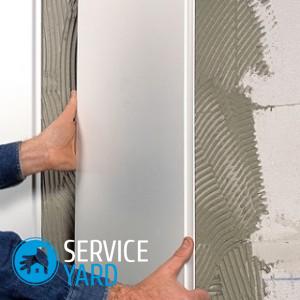Adhesive for PVC panels in the bathroom

Pasting the walls of the bathroom with PVC panels is quite widespread. A lot of tools are not required, dirt is also obtained at least, the aesthetic result fully lives up to expectations, especially with a modest budget for the repair of the bathroom. You can use “liquid nails” or a variety of adhesives. Consider how to apply glue to PVC panels in the bathroom.
to contents ↑Secrets of quality installation
There are 2 ways to install PVC panels in the bathroom:
- With the help of screws.
- Gluing.
It is undesirable to use self-tapping screws, because due to the frame, the wall finish “eats” part of the usable space. When mounting on glue, a frame is not needed, so the original dimensions of the bathroom are preserved. However, dismantling such panels is much more difficult.
to contents ↑How to choose glue for work?
There are a huge number of offers from various manufacturers on the market. Adhesives vary in properties, characteristics and price. When choosing which glue to glue PVC in the bathroom, consider three main criteria for a good glue composition:
- Transparency after drying.
- Neutrality to chemicals, resistance to temperature extremes.
- Fast setting and long action.
Important! Experts do not recommend the use of universal adhesive compositions. It is advisable to find glue that is used for a specific material.
So, on what glue to glue the PVC panels in the bathroom? Consider the most common types of adhesives:
- “Kleiberit 363.” Glue for plastic. It perfectly fixes the panels, moisture resistant, freezes very quickly.
- “Moment Crystal”. Compared to Kleiberit, it costs more. But with it you can fix the PVC panels to any kind of surface. Another benefit is transparency.
- “Emfikol 34012”. This is a highly specialized product designed exclusively for working with PVC. Its advantages: strength, viscosity, colorlessness.
- "Liquid Nails". A unique tool that sticks together even materials that are poorly compatible with each other.
to contents ↑Important! The high cost of glue is far from a guarantee of high quality installation. It is much wiser to carefully study the labeling and all the information associated with it - the material for which the composition, smell, degree of resistance to moisture, solidification time, the presence of antibacterial additives are intended.
What are liquid nails?
This is a universal bonding compound that allows you to create durable joints. Now about how to glue PVC panels in the bathroom with "liquid nails." The procedure for applying them is as follows:
- Prepare the surface (clean, level, treat against fungi, degrease). After that, let the wall dry.
- Apply “liquid nails” to the wall in the form of a grid, distributing the composition evenly. After this, it remains to attach the material to the wall and fix it with a rubber roller.
Important! Use silicone sealant to seal joints and joints.
If for some reason it is not possible to level the wall (or just do not want to), you can apply mounting to a metal or wooden crate. If you use wood, then before sheathing with plastic, treat it with a protective composition.
to contents ↑Important! Mounting on “liquid nails” can be used almost always.Panels made of fragile polymeric material are mounted almost instantly, while the PVC itself remains intact. The work is so simple and fast that even an inexperienced beginner can do it.
How to glue plastic panels in the bathroom? Features of the adhesive method:
- In order to mount PVC panels on glue, the height of the bumps should not exceed 3 mm. In this case, only tubercles represent the problem, the “pits” will be completely hidden.
- The preparation stage takes the most time: cleaning the wall of the remnants of the old wall covering, degreasing. If this step is performed efficiently, the rest of the work will go quickly. All that remains is to apply glue to the PVC strips and fix them to the wall.
Basic wall gluing tips:
- Distribute the composition on the surface of the mounted part. Then press it to the base and hold for several minutes. This is not an easy task, so it is better to use struts.
Important! The material is more firmly fixed to “liquid nails”. Packing of this composition is sufficient for gluing 5 "squares" of area.
- Do not apply glue to the edges of the material. If you neglect this rule, then the glue sticks out and spoils the appearance of the finish.
- The most important step is the installation of the first part, since all the others will be equal to it. It is necessary to verify the correct installation of the panel using the building level, and also fix it on top and bottom with dowels.
- Do not bend or crush material. You can remove the protective film only after the work is completed.
- If you need to cut PVC, then do it from the front.
- Do not use organic solvents. Plastic may deteriorate and stain.
Stock footage
PVC plastic is a budget, but aesthetic and practical alternative to ceramic tiles. If you do everything right, you can use the wall covering for a long time.
- How to choose a vacuum cleaner taking into account the characteristics of the house and coatings?
- What to look for when choosing a water delivery
- How to quickly create comfort at home - tips for housewives
- How to choose the perfect TV - useful tips
- What to look for when choosing blinds
- What should be running shoes?
- What useful things can you buy in a hardware store
- Iphone 11 pro max review
- Than iPhone is better than Android smartphones



